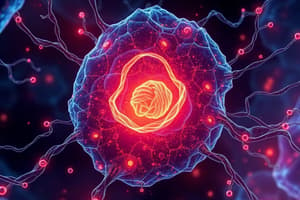Podcast
Questions and Answers
What is the characteristic of a heterotroph?
What is the characteristic of a heterotroph?
- Organism that is unicellular
- Organism that can produce its own food
- Organism that cannot produce its own food (correct)
- Organism that has a cell wall
What is unique about the movement of Amoeba?
What is unique about the movement of Amoeba?
- It uses cilia
- It uses flagella
- It uses pseudopodia (correct)
- It uses vacuoles
What is the function of chloroplasts in Microalgae?
What is the function of chloroplasts in Microalgae?
- To move
- To store food
- To synthesize food (correct)
- To reproduce
What is the cell wall composition of Microfungi?
What is the cell wall composition of Microfungi?
What is the mode of reproduction in Yeast?
What is the mode of reproduction in Yeast?
What is the characteristic of Paramecium?
What is the characteristic of Paramecium?
What is the function of vacuoles in Protozoa?
What is the function of vacuoles in Protozoa?
What is the characteristic of Microalgae?
What is the characteristic of Microalgae?
What is the main function of mitochondria in a cell?
What is the main function of mitochondria in a cell?
Which organelle is responsible for protein synthesis and transport?
Which organelle is responsible for protein synthesis and transport?
What is the primary function of lysosomes?
What is the primary function of lysosomes?
What is the function of the Golgi Apparatus in a cell?
What is the function of the Golgi Apparatus in a cell?
Which organelle is surrounded by a double membrane?
Which organelle is surrounded by a double membrane?
What is the primary function of vacuoles?
What is the primary function of vacuoles?
Which organelle is involved in the digestion of cellular waste and foreign substances?
Which organelle is involved in the digestion of cellular waste and foreign substances?
Which organelle is responsible for modifying and packaging proteins for secretion?
Which organelle is responsible for modifying and packaging proteins for secretion?
What is the main function of the cytoplasm in a cell?
What is the main function of the cytoplasm in a cell?
Which type of cell has DNA contained inside a membrane-bound nucleus?
Which type of cell has DNA contained inside a membrane-bound nucleus?
What is the role of ribosomes in a cell?
What is the role of ribosomes in a cell?
What is the main difference between prokaryotes and eukaryotes?
What is the main difference between prokaryotes and eukaryotes?
What is the function of the selectively permeable cell membrane?
What is the function of the selectively permeable cell membrane?
Which organelle is responsible for protein synthesis in a cell?
Which organelle is responsible for protein synthesis in a cell?
What is the function of DNA in a cell?
What is the function of DNA in a cell?
Which type of cell does not have membrane-bound organelles?
Which type of cell does not have membrane-bound organelles?
Flashcards are hidden until you start studying
Study Notes
Cell Organelles
- Mitochondria: compact spheres containing DNA and proteins, separated from the cytoplasm by a double membrane, sites of energy generation (ATP molecules) for the cell.
- Lysosomes: vesicles/sacs from the Golgi apparatus, containing enzymes for digestion.
- Vacuoles: membrane-bound cavities containing liquid, food, or secretions, controlling the movement of substances in and out of the cell.
Cell Types
- Prokaryotes: DNA exists 'free' in the cytoplasm, contains no membrane-bound organelles.
- Eukaryotes: DNA contained inside a membrane-bound nucleus, contains several membrane-bound organelles.
Microorganisms
- Protozoa: no cell wall, motile, exclusively heterotrophic, unicellular or multicellular, reproduction - asexual & sexual.
- Microalgae: autotrophs, cell wall - cellulose, chloroplasts - photosynthetic, unicellular, multicellular, filamentous, or colonial, reproduction - asexual & sexual.
- Microfungi: cell wall - cellulose or chitin, reproduction - spores (asexual/sexual)/budding, unicellular, multicellular, filamentous, examples - yeast, moulds.
Other
- Cytoplasm: the fluid of the cell, occupies most of the cell volume, site of most cellular activity/biochemical reactions.
- Ribosomes: large molecules involved in protein synthesis (assembly of amino acids).
- Pili: hair-like tubes for the transfer of DNA.
- Flagella: responsible for movement.
Studying That Suits You
Use AI to generate personalized quizzes and flashcards to suit your learning preferences.




